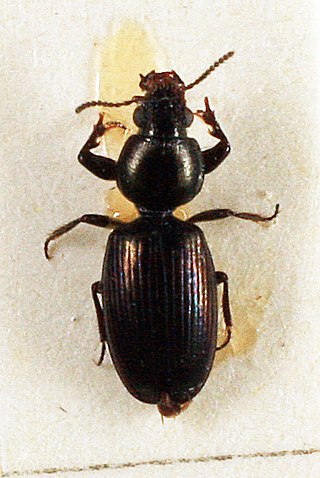| Laparocerus | |
|---|---|
 | |
| Laparocerus (Atlantis) lamellipes | |
| Scientific classification | |
| Domain: | Eukaryota |
| Kingdom: | Animalia |
| Phylum: | Arthropoda |
| Class: | Insecta |
| Order: | Coleoptera |
| Family: | Curculionidae |
| Genus: | Laparocerus Schönherr, 1834 [1] |
| Species | |
See text | |
Laparocerus is a genus of weevils of the family Curculionidae with 264 species and subspecies practically exclusive to central Macaronesia: the archipelagos of Madeira, Salvages and the Canaries. The two species present in western Morocco are attributable to a retro-colonisation from the Canary Islands to Africa. Over some nine million years, this lineage of Entiminae has generated some twenty-four monophyletic branches (subgenera) as a result of successive adaptive and geographic radiations, which have been significantly influenced by the geological dynamics of construction and dismantling typical of volcanic islands. [2]
Laparocerus have colonised practically all available habitats: dunes, semi-arid steppes, spurge formations, sclerophyllous forests, evergreen cloud forests, pine forests, high mountain meadows and scrublands, as well as the subterranean environment and volcanic tubes. The morphological diversity correlates with this ample ecological spectrum, with bodies adapted to climbing trees, feeding on shrubs, dwelling in the leaf litter or adapted to subterranean life (some of which are large and blind). Size ranges from 2.2 to 12.7 mm (0.1 to 0.5 in), excluding the rostrum. [3]
Adults are apterous and during the day they remain hidden, mostly buried. They come out at night to eat vegetation and copulate. The notches they leave in the leaves of trees and bushes are characteristic and serve to indicate the presence of these weevils, which are abundant and whose generic name in Spanish is "chascones". The females lay between 100 and 300 eggs (a record 1710 eggs) in clusters that they hide in crevices. Larval development lasts between 4 and 6 months but can continue up to a year if they enter diapause. The larvae are free-living and feed on plant roots. Adults live for 2 to 6 months [4]
Very few species occasionally leave natural habitats and cause damage to vines, peppers or other vegetables that are cultivated in their range. The survival of some very localised species is threatened, but in general and being so prolific, the conservation of most Laparocerus is not of concern.
This genus holds the record for biodiversity in Macaronesia and is an ideal model group for evolutionary studies. [3]









